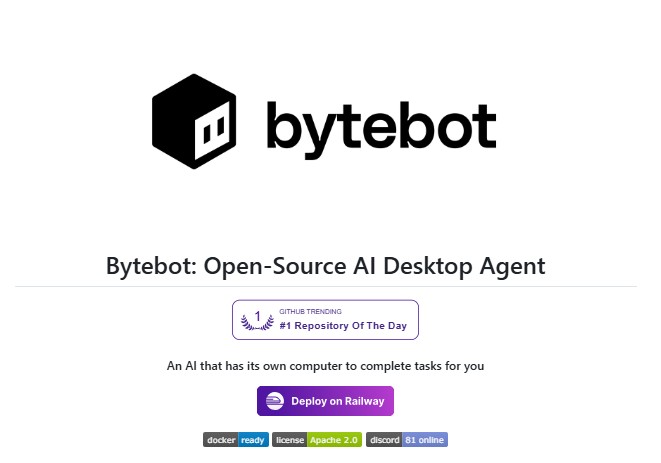In the era of rapid digital transformation, automation is the driving force behind business efficiency and innovation. While most AI agents are limited to browsers or APIs, a groundbreaking open-source project called Bytebot has redefined what AI can achieve. Bytebot introduces a self-hosted AI desktop agent — a virtual computer that performs complex, multi-step tasks across applications just like a human would. Built by Tantl Labs and the open-source community, it empowers businesses, developers and researchers to automate desktop workflows using natural language commands.

This article explores how Bytebot works, what makes it unique and why giving AI its own computer is a game-changer for productivity and enterprise automation.
What is Bytebot?
It is an open-source AI agent designed to operate within a complete Ubuntu Linux desktop environment. Unlike traditional RPA (Robotic Process Automation) tools or browser-based assistants, Bytebot has its own virtual desktop. It can open applications, move the mouse, type, read documents, browse websites and even handle file downloads and authentication – all autonomously.
In simpler terms, Bytebot acts as a virtual employee with its own computer. Whether it’s reading invoices, summarizing reports or automating data entry, it performs tasks as a human would but with the precision and consistency of AI.
Why Give AI Its Own Computer?
Traditional AI tools and browser-based agents are limited to specific environments or APIs. They cannot use native desktop applications or perform visual interactions like clicking, dragging or logging in using password managers. Bytebot solves this limitation by giving AI complete access to a desktop system enabling advanced workflows that go beyond browser automation.
Here’s what this approach unlocks:
- Complete Task Autonomy – Bytebot doesn’t just execute API calls; it performs end-to-end actions such as downloading files, logging into accounts and organizing folders.
- Document Intelligence – It can open PDFs, extract data, cross-reference files and even generate reports based on the extracted content.
- Cross-Application Workflows – Bytebot switches seamlessly between browsers, spreadsheets, text editors and command-line tools.
- Persistent Environment – Installed software remains available for future tasks, ensuring continuity and efficiency.
This makes Bytebot ideal for tasks that involve multiple systems, visual verification or data handling across applications.
How Bytebot Works ?
It operates through four tightly integrated components:
- Virtual Desktop – A full Ubuntu 22.04 environment with pre-installed tools such as Firefox, VS Code and common productivity applications.
- AI Agent – A backend service (built with NestJS) that interprets natural language commands and controls the virtual desktop.
- Task Interface – A Next.js web application that allows users to create tasks, upload files and watch Bytebot’s work in real time.
- APIs – RESTful endpoints for programmatic control and desktop automation.
Users can deploy Bytebot locally via Docker Compose or host it on Railway with just a few commands. Once deployed, tasks can be created through the web interface or API enabling seamless integration into existing workflows.
Key Features of Bytebot
- Natural Language Automation: Simply describe a task and Bytebot executes it.
- Live Desktop View: Watch the virtual desktop as Bytebot performs actions.
- File Uploads: Drop files into tasks for document processing.
- Takeover Mode: Manually take control of the virtual desktop when needed.
- Password Manager Integration: Works with Bitwarden, 1Password and other password managers for secure logins.
- Multi-Model AI Support: Compatible with OpenAI, Anthropic Claude, Google Gemini and over 100 AI providers through LiteLLM integration.
Practical Use Cases
Bytebot’s versatility makes it suitable for various industries and workflows:
1. Business Process Automation
Automate repetitive administrative tasks like invoice downloads, report generation and data consolidation. Bytebot can log into multiple vendor portals, download documents and compile summaries autonomously.
2. Document Processing
Upload a batch of PDF files and Bytebot can extract key details, identify payment deadlines or summarize contractual terms saving hours of manual reading and data entry.
3. Software Development & Testing
Developers can leverage Bytebot for UI testing, cross-browser validation and deployment verification. It can also capture screenshots and generate documentation automatically.
4. Research and Analysis
It assists researchers by gathering market data, analyzing trends across websites and compiling summaries or reports for decision-making.
Enterprise Deployment and Data Privacy
For organizations that prioritize control and data security, it offers self-hosting options via Docker or Kubernetes. Everything runs on the user’s infrastructure, ensuring full data privacy and no dependency on external cloud platforms. Enterprises can also customize their desktop environments by installing internal software, configuring APIs and integrating private datasets.
The Helm deployment option further allows scaling across Kubernetes clusters enabling enterprise-grade reliability and resource management.
The Open-Source Advantage
Bytebot’s open-source model encourages community collaboration and transparency. Users can inspect the source code, contribute improvements, or localize the interface into different languages. The project has already gained over 9,000 GitHub stars demonstrating its growing popularity and trust within the developer community.
Contributors are actively enhancing features, refining the AI interface and expanding integrations with more desktop applications and AI providers.
Conclusion
Bytebot represents a major leap forward in automation technology. By combining AI intelligence with a self-contained desktop environment, it bridges the gap between traditional automation tools and human-like digital assistants. Whether you are an enterprise seeking end-to-end workflow automation or a developer exploring the next frontier of AI agents, Bytebot offers a flexible, private and powerful solution.
With its open-source foundation, strong community support, and compatibility with leading AI models, Bytebot is not just an automation tool — it’s the blueprint for the next generation of autonomous AI systems.
Follow us for cutting-edge updates in AI & explore the world of LLMs, deep learning, NLP and AI agents with us.
Related Reads
- Claude-Flow v2.7: The Next Generation of Enterprise AI Orchestration
- Nanobrowser: The Open-Source AI Web Automation Tool Changing How We Browse
- Plandex AI: The Future of Autonomous Coding Agents for Large-Scale Development
- vLLM Semantic Router: The Next Frontier in Intelligent Model Routing for LLMs
- BERT: Revolutionizing Natural Language Processing with Bidirectional Transformers
